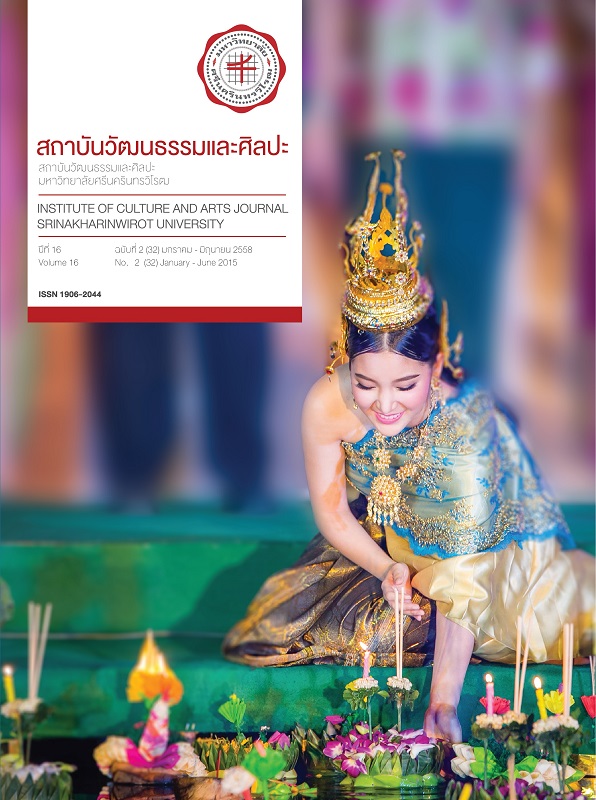การบริหารจัดการวงดนตรีไทยสากลในประเทศไทย : กรณีศึกษา วงดนตรีเกษมศรี วงดนตรีคีตศิลป์ และวงดนตรีสุภาภรณ์ THE MANAGEMENT OF THAI POPULAR BIG BANDS IN THAILAND CASE STUDY OF KASEMSRI, KEETASIL AND SUPAPORN POPULAR BIG BAND
บทคัดย่อ
บทคัดย่อ
วงดนตรีไทยสากล เป็นวงดนตรีที่บรรเลงเพลงด้วยเครื่องดนตรีตะวันตก โดยใช้โน้ตเพลงแบบสากล ขับร้องด้วยภาษาไทย เช่น วงดนตรีสุนทราภรณ์ หรือวงดนตรีกรมประชาสัมพันธ์ ซึ่งขับร้องเพลงไทยประกอบดนตรีสากล เช่น เพลงลูกกรุง การวิจัยครั้งนี้เป็นการวิจัยเชิงคุณภาพมีความมุ่งหมายดังนี้ 1) เพื่อศึกษาประวัติและผลงานของวงดนตรีเกษมศรีสุภาภรณ์ วงดนตรีคีตศิลป์ วงดนตรีสุภาภรณ์ 2) เพื่อศึกษาวิธีการบริหารจัดการ ของวงดนตรีเกษมศรีสุภาภรณ์ วงดนตรีคีตศิลป์ วงดนตรีสุภาภรณ์ ซึ่งเครื่องมือที่ใช้ในการวิจัย ได้แก่ แบบสำรวจเบื้องต้น แบบสัมภาษณ์ แบบสังเกต การมีส่วนร่วม และแบบสอบถาม โดยใช้ทฤษฎีมานุษยดุริยางควิทยาและ POSDCoRB ในเขตพื้นที่จังหวัดลพบุรี จังหวัดนนทบุรี และกรุงเทพฯ ระหว่างเดือนสิงหาคม 2552 – เดือนสิงหาคม 2555 พบว่า ประวัติวงดนตรีเกษมศรี ก่อตั้งโดย สมคิด เกษมศรี เมื่อ พ.ศ. 2517 วงดนตรีคีตศิลป์ก่อตั้งโดย วัชระ ปั้นศิริ เมื่อ พ.ศ. 2535 และวงดนตรีสุภาภรณ์ก่อตั้งโดย สุภาภรณ์ ชำนิราชกิจ เมื่อ พ.ศ. 2530 โดยมีผลงานเพลงของตนเองและนำเพลงสุนทราภรณ์มาบรรเลง วิธีการบริหารจัดการวงดนตรีไทยสากล พบว่า 1) การวางแผนการแสดงดนตรีกับวัตถุประสงค์ 2) การแบ่งหน้าที่ ได้แก่ นักร้อง นักดนตรี ฝ่ายจัดเตรียมโน้ตเพลงและเครื่องดนตรี 3) บุคลากรของวงดนตรี ได้แก่ หัวหน้าวงดนตรี นักร้อง นักดนตรี พนักงานจัดเตรียมเครื่องดนตรี 4) การควบคุมในการซ้อมดนตรี ด้วยการจัดให้มีการซ้อมดนตรีและควบคุมด้วยหัวหน้าวงดนตรี 5) การประสานงานให้รับทราบเกี่ยวกับวันเวลาของการแสดงและจัดเตรียมอุปกรณ์ 6) การประชาสัมพันธ์ในการจัดแสดง โดยการจัดทำแผ่นพับ แผ่นโฆษณางาน และประกาศงานทางวิทยุหรือทางโทรทัศน์ 7) ค่าตอบแทนในการจัดการแสดงมีความเหมาะสมกับขนาดของวงดนตรี
คำสำคัญ : ดนตรี, ดนตรีศึกษา, วงดนตรีไทยสากล, มานุษยดุริยางควิทยา, การบริหารจัดการ
ABSTRACT
The Thai popular big bands, derived and influenced by the western culture and music, when performed with Thai traditional melodies and lyrics combined, is a well proof of its popularity and serving as all-time favorite throughout Thailand. The objectives of this qualitative research are two folds: 1) Study of its history and achievements; 2) Study of the management techniques. The tools deployed were those of explorative and descriptive natures, based on i.e. surveys, interviews, observations, and participation. The designated areas are Lopburi, Nonthaburi provinces and the Bangkok Metropolitan. The research was carried out during August 2010 – December 2012. The constructive conclusions revealed that the early formations of the Thai popular big bands, i.e. Kasemsri (by Somkid Kasemsri in 1974), Supaporn (by Supaporn Chamnirachakit in 1987 and Keetasil (by Watchara Pansiri in 1992) respectively, with their own music arrangements, in terms of lyrics, melodies and chorus, using Suntaraporn characteristics as role model, fully reflected in their high standard of performances and public recognition. The key successful indicators engaged in maintaining effective band management and upholding current prominent achievements comprised of: 1) Efficient planning and organization – well corresponding to the objectives; 2) Clear division of assignments – Managers in charge of singers, notes/songs, musicians, instruments/installation; 3) Bands staffing – Band Manager, singers, musicians, musical equipment and coordinators; 4) Rehearsal schedules – under the full supervision of the Band Manager; 5) Coordination of equipment – timely notification of performing rosters and preparation of adequate musical instruments; 6) Public Relations – ensuring wide media coverage (TV, radio, brochures/ advertisements); 7) Honorarium – moderate rate and in good proportion of the band scale. The successful result of seamless operation during the entire concerts and the continued work flows is the clear indication of the proper application and full utilization of the Ethnomusicology and POSDCoRB Theory in the Thai popular bands.
Keywords: Music, Music Education, Ethnomusicology, Thai popular big band, Management
Downloads
ดาวน์โหลด
เผยแพร่แล้ว
รูปแบบการอ้างอิง
ฉบับ
ประเภทบทความ
สัญญาอนุญาต
บทความทุกบทความที่ได้รับการตีพิมพ์ถือเป็นลิขสิทธิ์ของวารสารสถาบันวัฒนธรรมและศิลปะ มหาวิทยาลัยศรีนครินทรวิโรฒ



